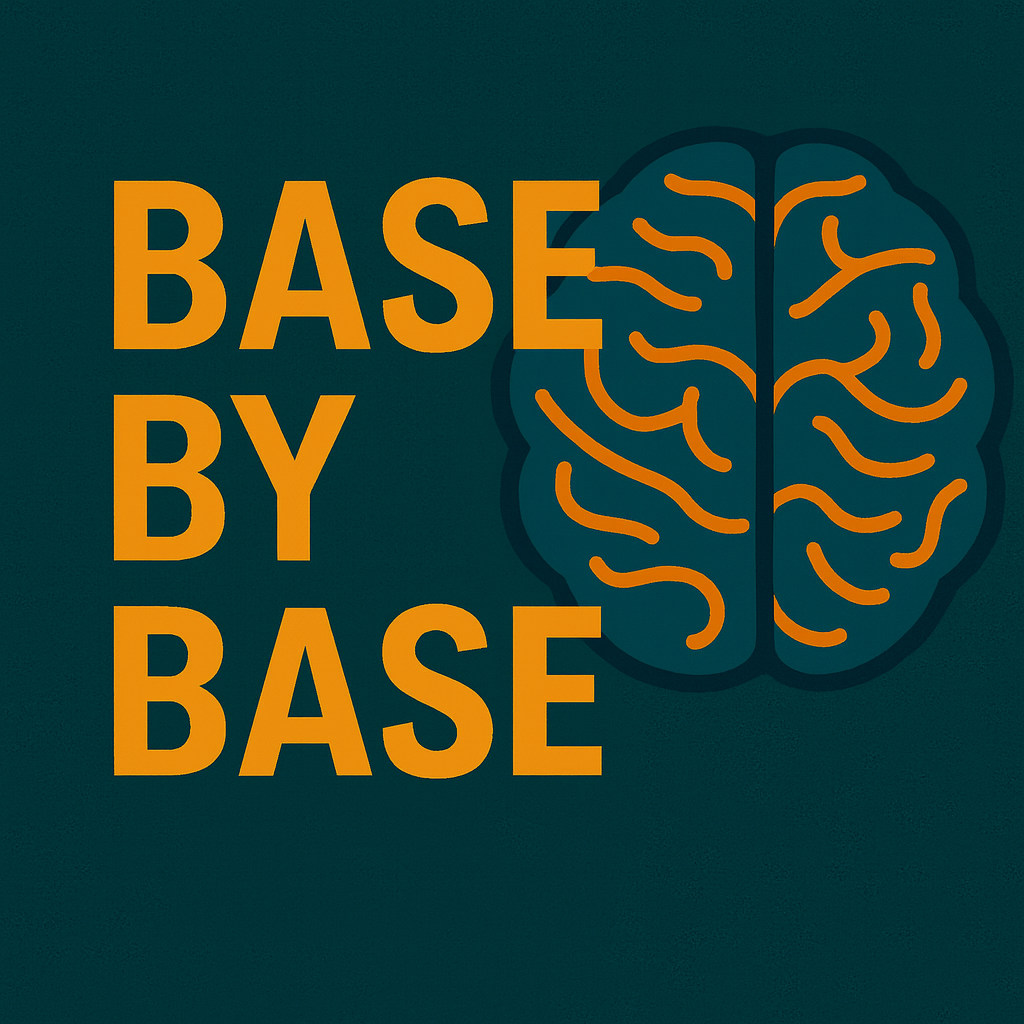Episode Transcript
[00:00:00] Speaker A: Foreign.
[00:00:14] Speaker B: Welcome to Base by Base, the papercast that brings genomics to you. Wherever you are. Imagine for a moment your body as this incredibly busy city, you know, powered by countless tiny energy plants. Every thought, every single movement, your heartbeat, it all relies on these little factories working just perfectly. Now, what if one of these, like, critical power plants didn't just slow down. What if it actually became, well, super inefficient, started burning fuel way too fast, almost frantically, creating lots of heat, lots of waste, but producing less and less of that vital energy the city needs to function. For some children, unfortunately, this isn't just hot experiment. They face things like unexplained developmental delays, really profound intellectual disabilities situations, severe movement disorders, conditions that, you know, dramatically impact their lives. And these symptoms can be so heartbreakingly confusing, they often point toward some kind of hidden glitch deep down in the cell engines, specifically their mitochondria.
[00:01:09] Speaker A: Right, and this is where the mystery really takes a turn. You'd think intuitively that a defect in an energy machine would just, well, slow everything down, a sort of powering down. But here's the really surprising twist that this research gets into.
Sometimes the body tries to compensate, and that actually leads to this paradoxical surge in activity.
[00:01:30] Speaker B: A surge?
[00:01:30] Speaker A: Yeah, like an engine revving much harder, but you're getting less power to the wheels. It's what we call uncoupling. A real disconnect between the effort and the actual energy output. And the question becomes, how could this counterintuitive mechanism just completely reshape how we understand these debilitating neurological conditions? It makes diagnosis and. And finding treatments, well, much more complicated than we maybe thought.
[00:01:52] Speaker B: Today, we're diving deep in some truly groundbreaking work. It's from a large collaborative team, really, spearheaded by researchers at Washington University in St. Louis School of Medicine. And they worked alongside significant contributions from the Undiagnosed Diseases Network and numerous other institutions, too. Their recent findings were accepted July 25, 2025, in MBO Molecular Medicine. And they're really advancing our understanding of these severe, severe neurological disorders, hopefully providing some new clarity for families, too.
Okay, so let's unpack the basic science here a bit. Our bodies, every single cell, they run on energy. And that energy mainly comes from a molecule called ATP. You can think of ATP as, like, the universal currency your cells use for basically everything. Thinking, moving, signaling. It's just fundamental to life. So where is most of this vital currency actually minted?
[00:02:41] Speaker A: Yeah, absolutely. The vast majority. Something like 90% of our ATP is generated in our mitochondria. They're famously called powerhouses of the cell. And for very good reason. Inside these tiny organelles, there's this complex process called oxidative phosphorylation, or occuphos.
[00:02:57] Speaker B: Right.
[00:02:57] Speaker A: And that process works tirelessly to turn fuel, you know, food into usable energy, into ATP. It's an incredibly intricate system when it's all working correctly.
[00:03:06] Speaker B: And right at the core of this OCX BHOS pathway is this really complex molecular machine called ATP synthase, also known as complex V. It's just a marvel of biochemical engineering, really, made up of many different protein parts, subunits that have to fit together with incredible precision like tiny gears and a perfect watch. Our deep dive today really zeroes in on one crucial part, the alpha subunit, and that's encoded by a gene called ATP5F1A.
[00:03:35] Speaker A: Okay.
[00:03:35] Speaker B: This alpha subunit forms a key part of what's called the F1 catalytic head. That's literally the spot where the ATP gets made.
[00:03:41] Speaker A: Right. And historically, genetic changes or variants in this ATP5F1A gene, they've been pretty rarely reported, which made them incredibly hard to diagnose. We knew about some severe, often fatal recessive forms. That's where a child gets two faulty copies of the gene, one from each parent.
More recently, a specific dominant de novo variant was described. Dominant, meaning you only need one faulty copy of de novo, meaning it's new in. The child, not inherited, was called PRQO7HIS. And what was really unique there was it caused these temporary neonatal issues that kind of surprisingly resolved clinically by about 18 months.
[00:04:17] Speaker B: Wow. Okay.
[00:04:18] Speaker A: But the challenge is many other variants found in this critical gene are still classified as of uncertain significance. Vuss.
[00:04:25] Speaker B: Right. VUS is the bane of genetic testing.
[00:04:27] Speaker A: Exactly. These families, completely in limbo, no clear answers, no clear path for treatment. So we urgently need to figure out what these variants are actually doing, you know, functionally inside the cell.
[00:04:38] Speaker B: So given that really complex picture, how do you actually figure out what one tiny genetic change means for a whole person?
This team used a, well, a fantastic multi ponged approach, really comprehensive.
[00:04:52] Speaker A: They started off with advanced genomic tools, clinical exome sequencing, whole genome sequencing.
[00:04:58] Speaker B: They have the hitters, right?
[00:04:59] Speaker A: These, let them pinpoint these very rare de novo heterozygous missense variants in six children who had these severe neurological conditions. It's like a super detailed search across the whole genetic code. Then to sort of predict the potential impact, they use sophisticated bioinformatic tools. Cad, Revel Mutation, taster.
[00:05:18] Speaker B: These are computational tools.
[00:05:19] Speaker A: Exactly. They're advanced models that basically Compare the new variant to known data, trying to predict how likely it is to damage the protein's function.
[00:05:26] Speaker B: But prediction isn't proof.
[00:05:28] Speaker A: Not at all. And this is where the really cool detective work starts. To understand the mechanism of how these variants actually cause disease. They didn't just stop at predictions, they built models.
[00:05:38] Speaker B: Models? Like computer models?
[00:05:40] Speaker A: Yeah, sophisticated 3D molecular modeling. They could visualize precisely where these specific amino acid changes landed on the ATP synthase protein structure. This lets you see right down at the atomic level, how a tiny change might mess up the protein's shape, its stability, or how it connects with other parts.
[00:05:57] Speaker B: That's incredible.
[00:05:58] Speaker A: And critically, they also turned to a maybe surprising but really powerful ally for in vivo studies, studies in a living organism, which was the nematode worm.
[00:06:10] Speaker B: Ah, the workhorse.
[00:06:11] Speaker A: It really is. This tiny worm is fantastic for genetics because its version of the gene ATP1 is highly conserved. It's remarkably similar to the human ATP5F1A gene. So using CRISPR Cas9 gene editing, they could precisely insert the human patient variants to directly into the worm's genome. Wow. Yeah. This gives you an amazing chance to see the functional consequences in a whole living system. You can watch how it affects development, movement, stress responses.
[00:06:38] Speaker B: Okay, and you mentioned this dominant negative idea earlier, the faulty protein messing things up for the good protein. How did they test that?
[00:06:44] Speaker A: Ah, right. They did these really clever gene dosage studies. It's quite an elegant approach actually. They took the worms that had the human variant and then they added extra copies of the normal healthy wild type gene back in.
[00:06:55] Speaker B: Okay, so flooding the system with worms, good copies, kind of.
[00:06:59] Speaker A: The idea is to see if having more of the good protein can overcome or rescue the negative effects caused by the variant protein. It's a classic way to tell if the faulty protein actively interfering, that's dominant, negative, versus just not having enough good protein around, which is haploin sufficiency, a really key distinction.
[00:07:18] Speaker B: Makes sense.
[00:07:19] Speaker A: And then finally they brought it all back to the patients. They validated everything using patient derived cells, skin fibroblasts and lymphoblastoid cells taken from the kids. And here they did a whole battery of biochemical and mitochondrial physiology tests.
[00:07:34] Speaker B: Like what specifically?
[00:07:35] Speaker A: Well, things like blue native page or BN page. It's a technique that lets you see if the whole complex V machine, the ATP synthase, is assembled correctly. And if it's there in the right amounts. They use western blots to look at specific protein levels, confirming if subunits were missing or reduced.
Then advanced mass spectrometry Proteomics gave them this incredibly detailed picture of all the components within the complex.
[00:08:00] Speaker B: A full inventory?
[00:08:01] Speaker A: Pretty much. And they also measured exactly how efficiently the cells were breathing oxygen using a seahorse bioanalyzer, Checked the mitochondrial battery charge using a dye called tmre, and directly measured the cellular ATP levels. How much energy are the cells actually making?
[00:08:17] Speaker B: Wow, that is thorough. Covering it from all angles.
[00:08:19] Speaker A: Exactly. This multi layered approach gives you a really robust and incredibly detailed understanding of what these variants are doing at the cellular level.
[00:08:27] Speaker B: So this deep dive, what were the big discoveries? What did all this work actually reveal about these new variants?
[00:08:32] Speaker A: Well, they identified six probands. That's the term for the affected individuals in the study.
[00:08:36] Speaker B: Right.
[00:08:37] Speaker A: And these six children had four specific heterozygous de novo missense variants in ATP 5F 1A.
The specific changes were PR182DLN, PSER3, 460PHI, P, P331LUN, and P. LU109, sir.
[00:08:52] Speaker B: Okay, and just to remind people, the P means it's a change at the protein level. Right? A specific amino acid swap.
[00:08:58] Speaker A: Precisely. An amino acid change at a particular spot in the protein sequence. And these were all brand new spontaneous mutations in these children.
[00:09:07] Speaker B: And what about the clinical picture? What symptoms did these kids have?
[00:09:10] Speaker A: It was complex and definitely challenging for the families, but there was a striking consistency. All six children presented with significant developmental delays, intellectual disability, and really prominent motor symptoms. Things like dystonia. That's where you get involuntary muscle contractions causing twisting movements and spasticity, which is a kind of muscle stiffness.
[00:09:33] Speaker B: And you mentioned this was different from that earlier variant, the PR207, his one critically different, yes.
[00:09:38] Speaker A: Remember that one resolved clinically. But for these children, their symptoms, their phenotypes were either static, staying the same, or more often, actually worsening over time.
[00:09:47] Speaker B: Oh, wow.
[00:09:47] Speaker A: Yeah. Indicating much more persistent and severe condition. And that difference for variants in the same gene is incredibly important.
[00:09:55] Speaker B: So did the modeling give any clues why these new variants were so much worse?
[00:09:59] Speaker A: It really did.
The structural modeling gave a huge clue. They found that all four of the affected amino acid residues were located right at critical contact points.
[00:10:08] Speaker B: Contact points between what?
[00:10:10] Speaker A: Between the alpha subunit, the 1 encoded by ATP5F1A, and the beta or gamma subunits within that F1 complex.
So this strongly suggested these variants weren't just causing, like a mild weakness. They were actively disrupting how the whole ATP synthase machine fits together and functions. Like jamming a wrench right into the gears.
[00:10:30] Speaker B: Okay, that makes sense. And the C. Elegans studies. Did they back this up?
[00:10:33] Speaker A: Powerfully. They provided really strong in vivo evidence. The worms carrying these human variants showed clear problems. Developmental abnormality. They moved much slower, and they had a strong mitochondrial stress response. You could actually see it because they used a fluorescent marker, HSP6P GFP, that lights up when the mitochondria are stressed. Like a little warning light. Wow. And here's the fascinating part relating to the dominant negative idea. When they added those extra healthy copies.
[00:11:00] Speaker B: Of the gene back in the rescue experiment.
[00:11:02] Speaker A: Exactly. It successfully suppressed that mitochondrial stress signal and rescued some of the other defects as well.
[00:11:08] Speaker B: Okay, so that strongly points to that dominant negative mechanism. Right. The bad protein is actively causing trouble.
[00:11:14] Speaker A: Incredibly strong evidence. Yes. The faulty protein is actively sabotaging the function of the normal protein. That's also there.
[00:11:22] Speaker B: Okay, now bring it back to the human cells. The patient fibroblasts.
What did you see there?
[00:11:28] Speaker A: So, in those patient derived cells, they saw a clear, marked reduction in the enzyme activity of complex V and also a decreased amount of several complex V subunits, including the ATP5F1A protein itself. Right, and the big proteomics analysis confirmed this wasn't just one or two subunits. It was a widespread reduction across almost all the complex V subunits. So the whole machine was being affected.
[00:11:53] Speaker B: Okay, so less activity, less protein. That sounds like what you might expect. Maybe.
[00:11:57] Speaker A: Yes. But wait until you hear this next part. This was the truly unexpected result coming from the mitochondrial physiology studies, despite the cells actually having higher rates of oxygen consumption, both basal and maximal rates.
[00:12:08] Speaker B: Meaning they were burning fuel faster. Trying harder.
[00:12:11] Speaker A: Exactly. Trying harder. Despite that, these patient fibroblasts had a significantly lower mitochondrial membrane potential. That's like the battery charge. And really diminished levels of cellular ATP.
[00:12:23] Speaker B: Whoa. So working harder, burning more fuel, but making less energy.
[00:12:27] Speaker A: Precisely. That is the absolute classic, textbook hallmark of uncoupled oxidative phosphorylation.
[00:12:34] Speaker B: The uncoupling you mentioned at the start.
[00:12:35] Speaker A: That's it. It's exactly that scenario.
[00:12:37] Speaker B: Yeah.
[00:12:37] Speaker A: The engine running inefficiently hot, burning more fuel, but producing much less usable energy. Yeah, and this is a stark, stark Contrast to that PR207. His variant, the one that resolved that one showed lower oxygen consumption. So this implies a completely different and likely much more damaging way. The cel energy production is failing.
[00:12:56] Speaker B: That's fascinating. And you said even the shape of the mitochondria changed in the worms.
[00:13:00] Speaker A: Yeah, that also supported this idea. In the worms with these variants, the mitochondria became more rounded, sort of globular and that morphology, that shape, is often seen when mitochondria are uncoupled, when the energy production is kind of going haywire and they can't maintain their normal efficient structure. It's like a visual sign of that engine overheating.
[00:13:19] Speaker B: Okay, so let's connect this to the bigger picture then. What do these findings really mean?
[00:13:23] Speaker A: Well, they significantly expand our understanding of diseases linked to ATP 5F 1A. We now know of 12 individuals with these heterozygous variants. And based on this growing evidence, ATP 5F 1A is now recognized as the most frequent nuclear genome cause of complex V deficiency.
[00:13:42] Speaker B: Most frequent? That's huge.
[00:13:43] Speaker A: It's a massive shift in how we think about diagnosing these conditions. Imagine a family, right, with a child suffering from these unexplained neurological symptoms. They might have been on a diagnostic odyssey for years, just searching for answers. Now, knowing ATP 5F 1A is the most frequent nuclear cause, it jumps way up the list of suspects. It helps streamline the diagnostic process, offers hope for earlier answers, and potentially ends that incredibly painful search.
[00:14:09] Speaker B: So what does this mean for, you know, the listeners, clinicians, researchers, maybe even patients or families listening for clinicians?
[00:14:17] Speaker A: If they find a variant of uncertain significance in ATP 5F 1A, there's now a much clearer path to figure out if it's actually causing the problem. This kind of multi method approach, combining the genetics, the model organism studies, like in the worms, the patient cell analysis, it gives them tools for confirmation that precision is absolutely vital for accurate diagnosis and managing the patient's care. It moves things from uncertainty towards clarity.
[00:14:44] Speaker B: That makes a huge difference.
[00:14:46] Speaker A: Absolutely. And it also raises this really important biological question, why? Why do different variants in the exact same gene cause such different problems?
This study just vividly shows that not all dominant ATP 5F 1A variants work the same way. This uncoupling mechanism is clearly distinct from others like the PRG207 his one. It really highlights why we need detailed functional analysis for each new variant we find. You just can't assume they all work the same way. The specific change really matters.
[00:15:16] Speaker B: Yeah, absolutely. And that integrated approach, the researchers used, the structural modeling, the C. Elegans genetics, the patient cell biochemistry, it feels like a blueprint, doesn't it?
[00:15:26] Speaker A: It really does.
[00:15:27] Speaker B: For how we should be tackling these complex genetic diseases in the future to understand them and hopefully move towards treatments. What do you think are the biggest hurdles to using this kind of deep dive approach more widely for rare diseases?
[00:15:40] Speaker A: That's a really good question.
Probably the Biggest hurdles are resources and expertise. Each of these methods, the modeling the worm genetics, the advanced cell physio, they all require highly specialized knowledge and frankly, expensive equipment. So scaling this up to do deep functional analysis for, you know, hundreds or thousands of variants and all the other rare disease genes, it's going to take huge collaborative efforts, significant funding, and also training scientists who can bridge these different disciplines.
[00:16:07] Speaker B: A big challenge.
[00:16:08] Speaker A: A big challenge. But the potential payoff for patients and families is just immense. And interestingly, this whole uncoupling mechanism, it's not totally unique to ATP 5F 1A.
[00:16:19] Speaker B: Oh, really?
[00:16:20] Speaker A: Yeah. Similar things have been seen with some dominant negative variants in ATP 5F 1B, which is another subunit of complex V, and even way back in historical studies of yeast mutants called mingme mutants. So it suggests there might be this sort of conserved vulnerability in this critical energy pathway across different species, which gives us broader insights into mitochondrial problems generally.
[00:16:39] Speaker B: So wrapping this up then, our deep dive today really reveals that these novel de novo dominant negative variants in the ATP5F1 DNA gene mess up the mitochondrial ATP synthase.
This leads to severe progressive neurological disorders, often because they cause this uncoupling of oxidative phosphorylation, meaning the cell's energy factories work harder, burn more fuel, but end up producing less usable energy. A profound energy crisis in the cell.
[00:17:07] Speaker A: Exactly. And this work powerfully underscores that just one gene can have diverse ways of causing disease, diverse pathogenic mechanisms leading to very different outcomes. Which really pushes us to ask, you know, what does this mean for developing targeted therapies? If one gene can cause disease through such different malfunctions, will we need an equally diverse range of precision medicines, maybe tailored not just to the gene, but to the specific way it's malfunctioning?
[00:17:31] Speaker B: A really complex puzzle for the future?
[00:17:33] Speaker A: Absolutely. But one with huge implications for personalized medicine.
[00:17:36] Speaker B: This episode was based on an Open Access article under the CCB Y 4.0 license. You can find a direct link to the paper and the license in our episode description if you enjoyed this, follow or subscribe in your podcast app and leave a five star rating. If you'd like to support our work, use the donation link in the description. Thanks for listening and join us next time as we explore more science base by base.




